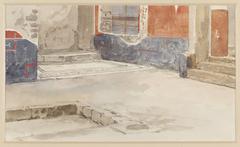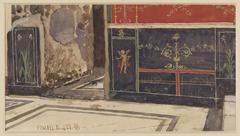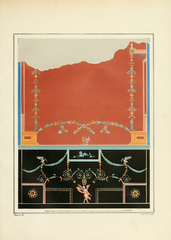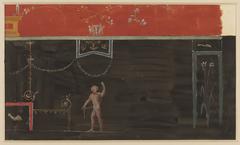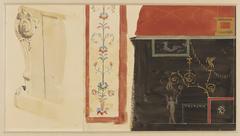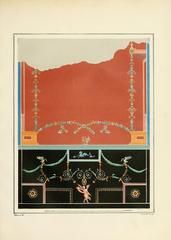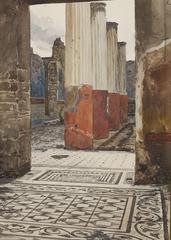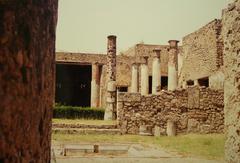
Casa di Trittolemo, Pompeii, Italy: Visiting Hours, Tickets, and Historical Sites Guide
Date: 14/06/2025
Introduction
Casa di Trittolemo stands as one of Pompeii’s most captivating domus, offering a vivid journey into ancient Roman domestic life, elite artistry, and innovative urban design. Distinguished by its stunning Fourth Style frescoes, dual atria and peristyles, and rare mosaics, this house encapsulates the cultural sophistication and social aspirations of Pompeii’s upper classes during the late Republican and early Imperial periods. Constructed in the 2nd century BCE and expanded after 80 BCE, Casa di Trittolemo reflects both the city’s transition under Roman rule and the evolving ambitions of its inhabitants.
This comprehensive guide provides essential information on visiting hours, ticket options, accessibility, site highlights, conservation efforts, and practical tips, ensuring a seamless and enriching experience. Whether you are a history enthusiast, art lover, or casual traveler, Casa di Trittolemo promises an unforgettable window into the world of Pompeii.
For official updates, visit the Pompeii Archaeological Park website and explore related resources such as Pompeii in Pictures and Eupedia.
Table of Contents
- Welcome to Casa di Trittolemo: Essential Visitor Information
- Architectural Layout and Evolution
- Artistic Significance
- Innovations and Influences
- Visitor Information
- Restoration and Conservation Efforts
- Visitor Management and Responsible Tourism
- Practical Tips for Visiting
- Interpretive Highlights
- References
Welcome to Casa di Trittolemo: Essential Visitor Information
Visiting Hours and Ticket Information
Casa di Trittolemo is part of the Pompeii Archaeological Park. As of June 2025, the site is open daily from 9:15 AM to 6:20 PM (last entry at 6:00 PM), except January 1, May 1, and December 25 (italy-sights.info). Hours may vary seasonally, so always check the official website before your visit.
Tickets to Casa di Trittolemo are included in the general Pompeii Archaeological Park admission. Children under 18 enter free with valid ID. Reduced rates are available for EU citizens aged 18–25. Purchase tickets online in advance to avoid long queues, especially during peak tourist seasons (italy-sights.info).
Getting There and Accessibility
Located in Regio VII, Insula 7, near the Basilica and Forum, Casa di Trittolemo can be accessed via the main park entrances. The nearby Pompeii Scavi–Villa dei Misteri train station offers convenient train connections from Naples and Sorrento. The “Pompei per tutti” (Pompeii for All) pathway, with ramps and elevators, facilitates access for visitors with disabilities (pompeiisites.org).
Historical Background and Development
Originally constructed in the 2nd century BCE, Casa di Trittolemo underwent significant expansion after the Sullan colonization in 80 BCE, merging with neighboring properties to create a complex with two atria and two peristyles—a rare and prestigious architectural feature (Eupedia). Its location, facing key urban landmarks like the Basilica and Sanctuary of Apollo, attests to the owner’s prominence.
Site Highlights
- Triptolemus Fresco: The triclinium features a renowned fresco of the mythological figure Triptolemus receiving wheat from Persephone, symbolizing fertility and abundance.
- Mosaic Floors: Exceptional black-and-white mosaics, especially a three-dimensional cube pattern (opus tessellatum), create optical illusions and showcase Roman decorative artistry.
- Architectural Layout: The domus features a grand atrium, private bath complex, and lush peristyle gardens, reflecting luxury and innovation.
Nearby Attractions
Enhance your visit by exploring nearby Pompeii landmarks:
- Basilica: The civic and judicial heart of ancient Pompeii.
- Sanctuary of Apollo: A significant religious site.
- Forum: The city’s bustling political and social center.
Guided Tours and Special Events
Guided tours are available in multiple languages through the park and private operators, often including Casa di Trittolemo among other elite residences. Special events and thematic tours are occasionally held; consult the official website for updates.
Photography Tips
Photography without flash is allowed. For optimal lighting, visit during morning hours. Professional equipment requires prior authorization.
Frequently Asked Questions (FAQ)
Q: Is Casa di Trittolemo included in the general Pompeii ticket?
A: Yes, access is included with standard admission.
Q: Are guided tours available?
A: Yes, both official and private guided tours are offered.
Q: Is the site accessible for visitors with disabilities?
A: The “Pompei per tutti” route provides ramps and elevators, though some ancient surfaces remain uneven.
Q: Can I bring pets?
A: Small dogs on leashes are allowed but must be carried inside buildings.
Architectural Layout and Evolution
Urban Context and Site Plan
Casa di Trittolemo occupies a prime location in Pompeii—Regio VII, Insula 7—directly facing the Basilica and adjacent to the Forum, highlighting its elite status (Italia-Italy; Pompeii in Pictures). The house’s integration with nearby shops and secondary entrances illustrates the blend of residential and commercial life in ancient Pompeii (pompeii.pictures).
Structural Features and Materials
Early construction employed local tufa and volcanic stone, with later renovations incorporating refined masonry and decorative stucco (Maria Milani). The house’s dual atria and peristyles accommodated both public reception and private family life, while a private bath complex added to its luxury (Madain Project).
Courtyard and Garden Spaces
The peristyles—colonnaded courtyards—housed lush gardens and water features, offering visual delight and a cooling microclimate. These spaces fostered a seamless connection between the indoors and outdoors (GBOpera).
Artistic Significance
Wall Paintings and Frescoes
Casa di Trittolemo’s Fourth Style frescoes (mid-1st century CE) are renowned for their vibrant colors, mythological scenes, and intricate architectural vistas (Eupedia). The Triptolemus fresco in the triclinium and the depiction of Venus on a Triton’s back are highlights. Restoration completed in 2014 has revived their original brilliance (Archeologia Voci dal Passato).
Mosaic Floors
The main reception room features a rare three-dimensional cube mosaic, while other rooms display black-and-white and colored mosaics reflecting the latest fashions of the late Republic and early Empire (GBOpera).
Decorative Stucco and Ornamentation
Finely modeled stucco friezes, pilasters, and cornices accentuate the peristyles, creating elegant light and shadow effects.
Innovations and Influences
Casa di Trittolemo exemplifies the integration of Samnite traditions with Roman innovations, especially after the city’s colonization in 80 BCE (Maria Milani). The house’s legal inscriptions reflect negotiations between private and public urban interests (Pompeii in Pictures).
Visitor Information
Tickets and Visiting Hours
- Hours: 9:15 AM to 6:20 PM (last entry at 6:00 PM), but confirm on the official website.
- Tickets: Included in general admission. Buy online for convenience (italy-sights.info).
- Accessibility: “Pompei per tutti” route, with ramps and elevators; some uneven surfaces remain (pompeiisites.org).
Guided Tours and Travel Tips
- Official tours and audio guides are available.
- Combine with nearby sites like Casa del Marinaio and Villa Imperiale for a comprehensive experience.
Photography and Visitor Etiquette
- No flash photography; respect preservation rules.
- Pets: Small dogs allowed on leashes outside, carried inside.
Restoration and Conservation Efforts
Casa di Trittolemo benefits from ongoing conservation as part of the Great Pompeii Project, which includes:
- Structural Stabilization: Reinforcing walls, roofs, and floors.
- Environmental Protection: Installing drainage systems.
- Innovative Materials: Using breathable mortars and reversible consolidants.
- Emergency Response: Rapid intervention protocols for weather or accidental damage.
Staff are trained in advanced techniques and digital monitoring (e.g., 3D scanning and mapping). These efforts ensure the site’s preservation for future generations (Pompeii Archaeological Park; European Commission’s project overview).
Practical Tips for Visiting
- Maps and Signage: Use official maps and on-site signage for navigation (pompeii.pictures).
- Weather: Bring sun protection and comfortable footwear.
- Facilities: Restrooms and water fountains available; parking near main entrances (italy-sights.info).
- Best Times: Early morning or late afternoon for fewer crowds and better lighting.
Interpretive Highlights
- Art and Decoration: Admire the rare perspective cube mosaic and mythological frescoes.
- Social Insights: Graffiti and inscriptions offer a glimpse into everyday life (academia.edu).
- Economic Role: The house’s proximity to shops highlights Pompeii’s dynamic urban fabric.
Frequently Asked Questions (FAQ)
Q: Where can I buy tickets?
A: Online via the official Pompeii website or at the park entrance.
Q: What are the opening hours?
A: Typically 9:15 AM to 6:20 PM, but confirm before visiting.
Q: Is the site accessible for wheelchairs?
A: Yes, via dedicated pathways and ramps, though some surfaces are uneven.
Q: Are guided tours available?
A: Yes, in multiple languages, with optional audio guides.
Q: Can I bring pets?
A: Small dogs on leashes are allowed; must be carried inside buildings.
Summary and Recommendations
Casa di Trittolemo is a jewel among Pompeii’s archaeological treasures, offering unique insights into the art, architecture, and daily life of ancient Rome. Its strategic location, innovative design, and rich decorative program make it a must-see for any visitor. Plan ahead by checking current hours, booking tickets online, and considering guided tours for an enriched experience. Respect preservation guidelines and enjoy the opportunity to connect with a world preserved in remarkable detail.
For up-to-date information, conservation news, and tour options, consult the Pompeii Archaeological Park website and follow their social channels. Enhance your visit with digital resources like the Audiala app for expert commentary and interactive maps.
